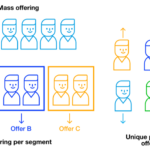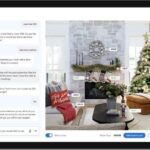With the passing of the traffic dividend era, the core of brand operation has changed from traffic operation to user operation.
In user operation, members, as brand loyal users, contribute more business to the brand and have a higher input-output ratio. According to statistics, when a company’s retention rate increases by 5%, its profits can increase by 25% to 100%. Therefore, efficient member operation strategy can help brand users to remain active, and at the same time, it can also obtain more high-potential new customers who are valuable to the store.
To achieve this object, first should better understand our users and achieve deep user insight segmentation. Intelligent label management of user information based on insight clustering.
However, many company data departments often want to drive business from the data level, based on their own past experience, comb and design hundreds of labels, but find that the business does not pay. If you want to get away from the “label making”, the core principle is: from the business to the business. Start with the end, and then from the business perspective, first understand the two important user label building models.
AIPL User Life Cycle Model
AIPL:The segmentation of the brand crowd and the quantification of the crowd assets are the most important part of the global marketing of the brand. AIPL stands for:
A(Awereness):Brand awareness crowd. There are mainly brand advertising exposure, page browsing, category word search crowd.
I(Interest):Brand interest crowd. The main brands click on advertisements, browse the brand home page/store home page, participate in brand interaction, browse the product details page, brand word search, subscribe/follow/join, add purchase collection crowd.
P(purchase):Brand buying crowd. Brand buyers
L(Loyalty):Brand loyal crowd. Repurchase, comment, share crowd.
Let’s talk about how this user model helps the brand better understand and serve its customers.

For example: a brand in the double eleven promotion period, to achieve the goal of GMV5000W, advertising should be placed to which groups of people, the amount of each group of people is how much? What is the release budget?
(1) Define AI as a new customer and PL as an old customer
(2) Based on historical data to see the contribution of new users and old users to GMV, we can get the GMV of the new users and old users.
(3) New customers: According to the historical data, the GMV ratio of AI can be obtained, and the customer unit price (historical data) and conversion rate (historical data) can be obtained to get the number of users: according to the formula GMV= number of users conversion rate Customer unit price
(4) Old customers: the number of old users is fixed, backpush, the number of people, conversion rate, customer unit price are historical data, can calculate the respective GMV of PL, calculate the GMV of old users is 2300, still 7 million short, but also have to work hard in the customers of old users, do some activities: Give some more coupons, or hold some activities and other measures to improve the conversion rate, and finally achieve the GMV of old customers.
RFM User Value Management Model
In the user segementation, RFM model is the most classic and most familiar user value management model. The RFM model is to divide eight user value groups by Recency, overall Frequency of purchase and Monetary spending, so that costs and efforts can be more accurately spent on the user level to achieve targeted marketing.

RFM model Includes three key factors:
R(Recency):It indicates how far away the customer’s last purchase is, that is, the most recent consumption, and the more recent the consumption time, the greater the value of the customer.
F(Frequency):It Indicates the number of times customers have purchased in the recent period of time, that is, the frequency of consumption, frequent purchase users are frequent customers, and the value is definitely greater than the value of customers who come once in a while
M (Monetary):ItIndicates the amount purchased by the customer in a recent period of time, that is, the consumption power of the customer. Usually, the average consumption amount of the customer is used as a measurement index. The more the user consumes, the greater the value of the user.

Using RFM analytics, marketers can quickly segment users into similar groups and target these users with different personalized marketing strategies, thereby increasing user engagement and retention. It is worth noting that the data characteristics and user behavior characteristics of different industries are not the same, so in the actual operation process, RFM rules will be formulated in line with their own company’s business characteristics, but the basic idea is the same.
How can smart tags identify high potential users
User labeling management can help brands understand consumers better and realize consumer empathy marketing. The creation of a scientific labeling system can give life to user portraits and maximize the value of customer life cycle at the lowest cost in a market environment where user acquisition costs are soaring. With the development of big data, AI algorithm technology and the upgrade of demand efficiency, intelligent label system has been applied.
Techsun’s core product, Socialhub.AI, has completed the intelligent labeling task of 400 million brand users. Social Hub smart label function, based on user behavior data and combined with various data sources such as business data, helps enterprises build a systematic label library and enables businesses to achieve self-service creation, maintenance and management of user labels, which is an important cornerstone for realizing refined user operation and precision marketing.

In the application of enterprise business scenarios, the Socialhub.AI smart label system provides the following values:
Customer 360° label management and crowd screening
• Marketers can screen appropriate target groups based on a variety of computational logic built into the system, and support multiple rules superposition in the AND or way to refine and screen label groups;
• View all dimensional portraits of the population to gain insight into the characteristics of the target population;
• Based on the attributes and characteristics of the product or marketing campaign, based on the user label portrait system, select the precise target group.
Customer differentiated marketing based on user profile
Based on customer label portrait and AI technology to achieve comprehensive insight into users, personalized customized push according to customer characteristics and needs, improve the conversion rate of products or activities.
Customer lifecycle marketing automation follow up
Through the marketing automation platform, the system automatically and continuously interacts with customers, and makes targeted marketing strategies according to customer feedback, effectively promoting the business transformation of the whole life cycle of customers.
High value customer loss warning
Based on the order, browsing, membership, activities and other dimensions of lost customers, predict the probability of loss of existing customers, differentiated marketing for different probability groups, and recover and maintain lost customers.
Content Marketing (Active/passive marketing)
Based on the customer label portrait system and combined with the AI algorithm model, active push is carried out for the crowd with different content screening and matching, or automatically push the content in line with their preferences according to the crowd characteristics, and timely return the actual effect data, continuously optimize the model parameters, and improve the content transformation.
User full life cycle operation and automation trigger
Based on the customer label portrait system, combined with AI algorithm model, for users in different life cycle stages and combined with label characteristics, customer triggered/differentiated operation at each stage is carried out, and the actual effect data is timely returned, the model parameters are continuously optimized, and the transformation of customers at each stage is improved.
Scientific and reasonable division of customer life cycle stages
The purchase cycle, retention cycle, loss cycle and other data of customers are continuously observed, combined with the parameter calculation of the personal buyback cycle, the rules of each stage of the customer life cycle are determined, and the customer life cycle is reasonably divided.
Wechat multi-public number data open and personalized operation
Connect the data of multiple public accounts/small programs and business systems, build a unique user ID, and conduct personalized operation for fans.
Individual portrait: Provide each user portrait information for e-marketing/customer service
Output individual labels and behavior tracks such as basic information of a single customer, recent interaction track, order record, etc., to help business personnel and users achieve targeted 1-to-1 communication, improve the communication effect, and achieve sales transformation.
Different from other label systems in the market, relying on the advantages of Social Hub real-time user behavior data collection and full-end data opening, the intelligent label system can collect multi-end data sources in real time, capture multidimensional attributes and dynamic changes of users, and make the label system rich and self-iterative.
For example: With the help of Techsun’s Social Hub, a multinational fast food chain brand can conduct in-depth analysis of user behavior in the three aspects of membership management, interactive marketing and content operation, and can iterate label data in real time.

In the member management link,the brand carried out the basic analysis of members (such as: age, gender, birthday, region, etc.), member registration analysis (such as: registration time, card opening, stored value, etc.), cumulative points, points consumption, points level, points exchange preference analysis.
In the interactive marketing link, the analysis of coupon collection and cancellation, coupon preferences, coupon collection data of each platform, coupon collection and sale users, coupon usage habits, and the number of participants, visitors and visits.
In the link of content operation, the analysis of push crowd, successful delivery, message click, participation in activities is carried out; Order data, user consumption time, consumption amount, consumption frequency, consumption preference, commodity data, store data and other analysis; Analysis of the number of visitors, number of visits, source channels, etc.
For the brand, the fundamental marketing is “people”, deep cultivation of high-potential people, is the key to the growth of brand business. In order to obtain definite long-term growth, it is no longer dependent on the erratic air outlet and traffic, but on the solid high-quality user base, as well as the continuous user cultivation ability throughout the daily, so that the brand can more firmly occupy the user’s mind.
The smart label function of Techsun Socialhub.AI, which is scientific and efficient, flexible in application, and self-visualized in management, greatly reduces the threshold of label creation, and helps customers realize applications such as refined customer life cycle management, in-depth exploration of high-potential customers, cross-marketing, personalized push, personalized recommendation, and personalized real-time marketing.Socialhub.AI
Recent Post
-
Retail enterprises how to build a personalized loyalty program
December 31, 2024 Retail Topic





